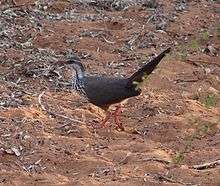Subdesert mesite
The subdesert mesite (Monias benschi) is a ground-dwelling bird endemic to Madagascar. It is one of three species in the mesite family Mesitornithidae, and is restricted in distribution to a small low-land region in southwest Madagascar.
| Subdesert mesite | |
|---|---|
 | |
| male | |
| Scientific classification | |
| Kingdom: | Animalia |
| Phylum: | Chordata |
| Class: | Aves |
| Order: | Mesitornithiformes |
| Family: | Mesitornithidae |
| Genus: | Monias Oustalet & Grandidier,G, 1903 |
| Species: | M. benschi |
| Binomial name | |
| Monias benschi Oustalet & Grandidier,G, 1903 | |
Description
The subdesert mesite is a medium-sized terrestrial bird which is often described as rail-like (a family with which the mesites are sometimes placed). The species has a long and downward-curved bill distinguishing it from the other members of the family. Both sexes are greyish above and show thin white eyebrows. Both have white underparts; the male has black crescent-shaped spots on the side of the neck and upper breast. The female has rufous spots that may merge into a general rufous tone, and has a tawny cheek patch.[2]
Distribution and habitat
The subdesert mesite is restricted to spiny thicket with open areas, from sea-level to an altitude of 130 m (430 ft). It is restricted to the 200 km (124.3 mi) long, and 30 to 60 km (18.6 to 37.3 mi) wide, coastal strip between the Fiherenana river and the Mangoky river, in the south-west of Madagascar. To the north of Manombo there is an area of circa 2,500 km2 (965 sq mi) where the habitat is still suitable; elsewhere the habitat is becoming fragmented.[3]
Behaviour and ecology
The subdesert mesite forages by picking invertebrates, seeds and fruit off the ground and may dig into the surface. The birds nests are exposed platforms of twigs built in a bush within 2 m (6.6 ft) of the ground. One or two eggs are laid and the incubation and care of the young is shared by both sexes. They may be polyandrous or polygynous. The birds live in communal groups and have a loud ″nak! nak!″ alarm call when disturbed.[4]
Status
The population of this species may be dense within its restricted geographic range. It is vulnerable to habitat degradation, by slash-and-burn cultivation of maize, burning for charcoal, commercial timber and for construction. which is happening in most of its range apart from to the north of Manombo. The birds are also taken by dogs, by hunting, and introduced rats (Rattus sp) may also be a problem. In 2002 there was an estimated population 115,000 and it is estimated that numbers are falling. The International Union for Conservation of Nature has classified the conservation status of this bird as ″vulnerable″.[3]
References
- BirdLife International (2012). "Monias benschi". IUCN Red List of Threatened Species. 2012. Retrieved 26 November 2013.CS1 maint: ref=harv (link)
- "Subdesert mesite (Monias benschi)". ARKive. Archived from the original on 2016-10-19. Retrieved 16 October 2016.
- "Monias benschi". IUCN Red List of Threatened Species. Retrieved 16 October 2016.
- "Subdesert Mesite Monias benschi". BirdLife International. Retrieved 16 October 2016.
- Handbook of the Birds of the World, Volume Three, Hoatzin to Auks; de Hoyo, Elliot and Sargatal, ISBN 84-87334-20-2
